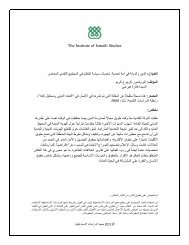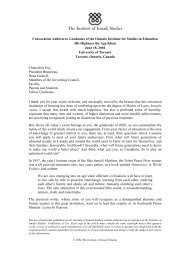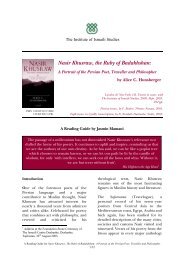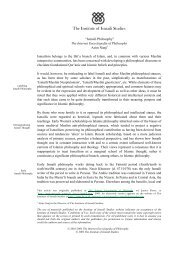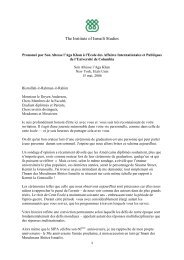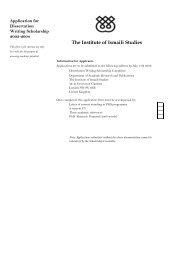The Institute of Ismaili Studies 1
The Institute of Ismaili Studies 1
The Institute of Ismaili Studies 1
Create successful ePaper yourself
Turn your PDF publications into a flip-book with our unique Google optimized e-Paper software.
Persia where authors such as Abu Ishaq Quhistani and Khayrkhah Harati produced the earliest<br />
doctrinal works <strong>of</strong> the post-Alamut period. In the context <strong>of</strong> Nizari-Sufi relations during the early<br />
Anjudan period, valuable details are preserved in the Pandiat-e javanmardi, containing the religious<br />
admonitions <strong>of</strong> Imam Mustansir bi’llah II or one <strong>of</strong> his descendants. In this book, the Nizaris are<br />
referred to with Sufi expressions such as ahl-i haqiqat, or the “people <strong>of</strong> the truth,” while the imam is<br />
designated as pir or murshid. <strong>The</strong> imam’s admonitions start with the shari‘at-tariqat-haqiqat<br />
categorisation <strong>of</strong> the Sufis, describing haqiqat as the batin <strong>of</strong> shari‘at which would be attained by the<br />
believers (mu‘mins) through following the spiritual path or tariqat. <strong>The</strong> Pandiat (text pp. 2-3, 11, 13,<br />
14, 34-36, 54-58, 65-68 and elsewhere) further explains, in line with the earlier Nizari teachings <strong>of</strong><br />
qiyama times, that haqiqat consists <strong>of</strong> recognising the spiritual reality <strong>of</strong> the imam <strong>of</strong> the time. <strong>The</strong><br />
Nizaris now essentially retained the teachings <strong>of</strong> the Alamut period, especially as elaborated after the<br />
declaration <strong>of</strong> qiyama. <strong>The</strong> current imam retained his central importance in Nizari doctrine, and the<br />
recognition <strong>of</strong> his true spiritual reality remained the prime concern <strong>of</strong> his followers (Abu Ishaq<br />
Quhistani, text pp. 19-20, 37-38, 53-54, 58, 67-68, tr., pp. 19-20, 37-38, 53-54, 58, 67-68; Khayrkhah,<br />
Kalam-e pir, text pp. 46, 72-73, 86, 95-96, 100, 114-16; . — —, Tasnifat, pp. 18 ff.).<br />
<strong>The</strong> advent <strong>of</strong> the Safavids and the proclamation <strong>of</strong> Twelver Shi‘ism as the state religion in 907<br />
AH/1501 CE, promised a more favourable atmosphere for the activities <strong>of</strong> the Nizaris and other Shi‘i<br />
communities in Persia. <strong>The</strong> Nizaris did, in fact, initially reduce the intensity <strong>of</strong> their taqiya practices.<br />
However, this new optimism was short-lived as the Safavids and their shari‘at-minded ‘ulama’ soon<br />
persecuted all popular forms <strong>of</strong> Sufism and those Shi‘i movements which fell outside the confines <strong>of</strong><br />
Twelver Shi‘ism. <strong>The</strong> Nizaris, too, received their share <strong>of</strong> persecutions. Shah Tahir Husayni (d. ca.<br />
956 AH/1549 CE), a learned religious scholar and the most famous imam <strong>of</strong> the Muhammad-shahi<br />
line, was persecuted in Shah Ismail’s reign (907 -30 AH/1501-24 CE). However, Shah Tahir, whose<br />
religious following and popularity had proved unacceptable to the Safavid ruler and his Ithna‘ashari<br />
scholars, fled to India in 926 AH/1520 CE and permanently settled in the Deccan where he rendered<br />
valuable services to the Nizam-shahs <strong>of</strong> Ahmadnagar. It is interesting to note that from early on in<br />
India, Shah Tahir advocated Twelver Shi‘ism, which he had obviously adopted as a form <strong>of</strong> disguise.<br />
He achieved his greatest success in the Deccan when Buhran Nizam-shah proclaimed Twelver<br />
Shi‘ism as the <strong>of</strong>ficial religion <strong>of</strong> the state in 944 AH/1537 CE. Shah Tahir’s successors as<br />
Muhammad-Shahi imams continued to observe taqiya in India mainly in the form <strong>of</strong> Twelver Shi‘ism<br />
(see Fereshta, Tarikh-e Fereshta, ed. J. Briggs, Bombay, 1832, II, pp. 213-31; ‘Ali b. ‘Aziz Tabataba,<br />
Bohran-e ma’ater, Hyderabad, 1936, pp. 251-70, 274 ff., 281 ff., 291, 308, 324-26, 338-39, 448-50,<br />
452-53, 584; Daftary, 1990, pp. 487-91).<br />
Meanwhile, Shah Tahmasp persecuted the Qasim-shahi Nizaris <strong>of</strong> Anjudan and had their thirty-sixth<br />
imam, Imam Murad Mirza, executed in 981 AH/1574 CE. By the time <strong>of</strong> Shah ‘Abbas I (995-1038<br />
AH/1587-1629 CE), the Persian Nizaris had successfully adopted Twelver Shi‘ism as a second form<br />
<strong>of</strong> disguise. Shah Tahir may have been the first Nizari imam to have conceived <strong>of</strong> this new form <strong>of</strong><br />
dissimulation, which was now adopted by the Qasim-shahi Nizari imams and their followers (see<br />
Daftary, 1990, pp. 471-74). By the end <strong>of</strong> the 11 th AH/17 th CE century, the Qasim-shahi da‘wa had<br />
gained the allegiance <strong>of</strong> the bulk <strong>of</strong> the Nizaris at the expense <strong>of</strong> the Muhammad-Shahis. <strong>The</strong> da‘wa<br />
had been particularly successful in Afghanistan, Central Asia and several regions <strong>of</strong> the Indian<br />
subcontinent. In South Asia, the Hindu converts became known as Khoja, derived from the Persian<br />
word khwaja (Nanji, 1978, pp. 50-83). <strong>The</strong> Nizari Khojas developed an indigenous religious tradition,<br />
known as Satpanth or the “true path” (to salvation), as well as a devotional literature known as the<br />
ginans . With the fortieth Qasim-shahi imam, Imam Shah Nizar (d. 1134 AH/1722 CE), the seat <strong>of</strong><br />
this branch <strong>of</strong> the Nizari da‘wa, then representing the only branch in Persia, was transferred from<br />
…Please see copyright restrictions on page 1<br />
20



